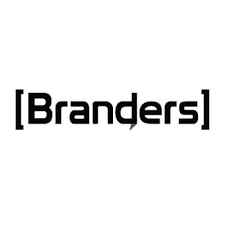As naming consultants we often distinguish between two common categories of brand naming, descriptive naming and suggestive naming. The first type of name makes it pretty clear what the product or company in question is all about. (Toys R Us, Raisin Bran, PlayStation, Vitaminwater, General Motors are all descriptive names.) The second type suggests the territory of the brand indirectly, and invites you to fill in the blanks with your own associations. (Think Droid, Twitter, Mountain Dew, Fitbit, Vudu.)
Although there are contexts in which a descriptive name can be just the ticket (more on that later), in general, suggestive naming is a much more engaging and powerful branding strategy.
Here’s an example that I stumbled upon yesterday that’s a testament to suggestive naming: a photo studio in my neighborhood called BlinkInc. The concept is neat. For fees starting at $25 for 10 minutes of studio time, you can arrange a professional photo shoot, view the results, and download the images you want, on the spot. The studio has the cool, spare designer look of an Apple store, and the company name Blink reinforces that mystique. It’s hip, it’s minimalist, and it gets at the spirit and benefit of the brand: playfully alluding to both the photographic experience and the fact that this particular experience is streamlined so it’s over in a blink. (Reinforcing the brand, each photo is referred to as a “blink.”) I had no idea from the store window what was on offer, but I was drawn to the name like a moth to flame.
Now contrast that deft suggestive name with the descriptive company naming of a similar service: Portrait Innovations. Unlike its suggestive counterpart, this descriptive name commits several cardinal sins. For starters, it’s dull and unmemorable. It also asks us to believe that the brand is innovative, rather than conveying why we should believe it: the surest way to activate a customer’s BS detector. (Let’s face it: most people think they have a great sense of humor, and most companies think they’re innovative. These are things you need to prove, not proclaim. And why would anyone take a company’s word that they’re innovative, when their brand name—and website—is so uninnovative?) Finally, the name is as cold and corporate as its subject matter is warm and fuzzy. This is a company that specializes in taking family photos . . . yet its brand name is about as human and inviting as an endodontist’s chair. It’s rare to find company naming so completely at odds with the enterprise it’s attempting to brand.
Another example of the perils of descriptive company naming is the Get In Shape For Women exercise studio in my neighborhood. Besides being a mouthful, this moniker is bland and generic, with a flatfooted construction (the name’s virtually a tagline). A look at the corporate website suggests there’s a good story to tell (small group personal training that encompasses nutrition as well as fitness) but the name does nothing to leverage it. Instead, the name’s lack of finesse and individuality suggests the most basic and minimal level of fitness expertise: not something likely to attract residents of a town where there are more tony exercise studios than there are gas stations. Get In Shape for Women may be a kickass studio franchise, but I’m not sure they’ll get a chance to prove it in my neighborhood. Unfairly or not, we judge books by their covers (which is why so many women want to get fit in the first place).
Compare the descriptive name Get In Shape For Women with the suggestive naming of the international fitness franchise known as Curves. While the franchise has spurred controversy because of the anti-abortion stance of one of its founders, there’s nothing controversial about the brand name, which is spot on. Without telling you exactly what the company does (it’s easy enough to peer inside the windows and see women exercising), the name Curves obliquely suggests an enterprise that’s all about women. It also evokes an acceptance and celebration of the uniquely female body, rather than an über-male approach to fitness that emphasizes leanness and muscle-building. And it positions the brand as accessible to everyday women who will never have the figures of teenage boys—er, runway models—no matter how much they exercise. That’s a lot of mileage for six little letters.
Bottom line: if you’re naming a consumer-facing company or product, you generally stand a much better chance of arousing customers’ curiosity and interest with a suggestive name.
There are exceptions of course. If you have a huge marketing budget and a great concept, you can make a descriptive name work. (Hello, The Container Store.) If you don’t want to steal your master brand’s thunder, a descriptive name can be a smart play. (Apple’s iPhone is doing quite nicely.) And if your B2B customers just want to know what a product does, then by all means be descriptive. But if your product or company naming challenge doesn’t fit these parameters, suggestive naming can be a great way to romance your brand by leveraging your customers’ imagination and desire. By not telling them exactly what to think, you can engage them in filling in the blanks with their own personal and positive associations. And who wouldn’t want to do that?



